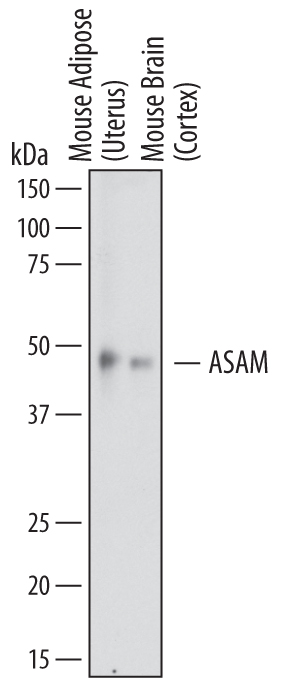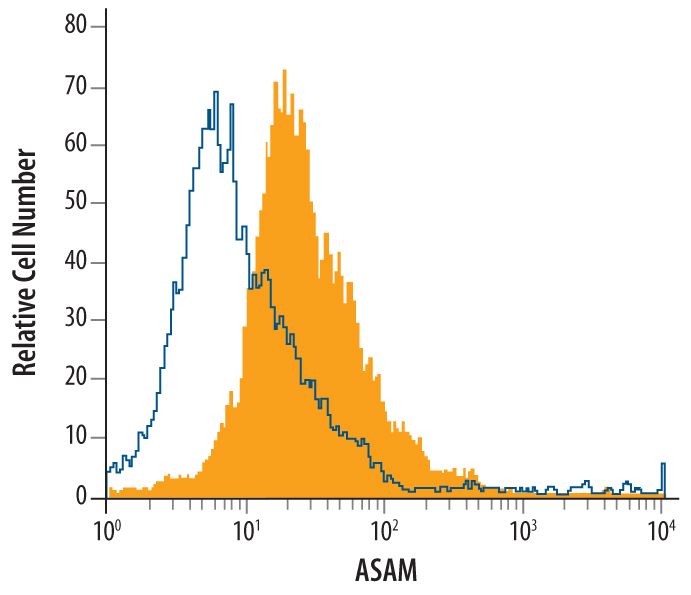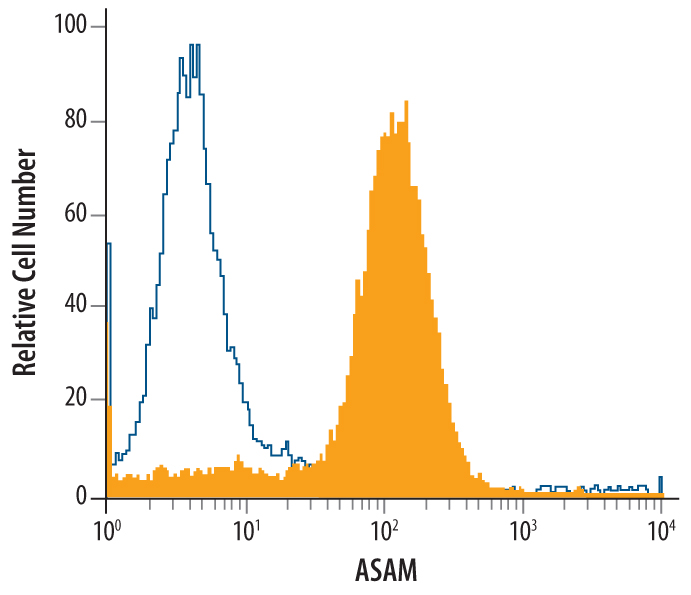Human/Mouse ASAM Antibody Summary
Thr18-Ala234
Accession # Q8R373
Applications
Please Note: Optimal dilutions should be determined by each laboratory for each application. General Protocols are available in the Technical Information section on our website.
Scientific Data
 View Larger
View Larger
Detection of Mouse ASAM by Western Blot. Western blot shows lysates of mouse adipose (uterus) tissue and mouse brain (cortex) tissue. PVDF membrane was probed with 1 µg/mL of Sheep Anti-Mouse ASAM Antigen Affinity-purified Polyclonal Antibody (Catalog # AF7356) followed by HRP-conjugated Anti-Sheep IgG Secondary Antibody (Catalog # HAF016). A specific band was detected for ASAM at approximately 48 kDa (as indicated). This experiment was conducted under reducing conditions and using Immunoblot Buffer Group 1.
 View Larger
View Larger
Detection of ASAM in RAW 264.7 Mouse Cell Line by Flow Cytometry. RAW 264.7 mouse monocyte/macrophage cell line was stained with Sheep Anti-Mouse ASAM Antigen Affinity-purified Polyclonal Antibody (Catalog # AF7356, filled histogram) or control antibody (Catalog # 5-001-A, open histogram), followed by Phycoerythrin-conjugated Anti-Sheep IgG Secondary Antibody (Catalog # F0126).
 View Larger
View Larger
Detection of ASAM in T98G Human Cell Line by Flow Cytometry. T98G human glioblastoma cell line was stained with Sheep Anti-Mouse ASAM Antigen Affinity-purified Polyclonal Antibody (Catalog # AF7356, filled histogram) or control antibody (Catalog # 5-001-A, open histogram), followed by Phycoerythrin-conjugated Anti-Sheep IgG Secondary Antibody (Catalog # F0126).
Reconstitution Calculator
Preparation and Storage
- 12 months from date of receipt, -20 to -70 °C as supplied.
- 1 month, 2 to 8 °C under sterile conditions after reconstitution.
- 6 months, -20 to -70 °C under sterile conditions after reconstitution.
Background: ASAM
ASAM (Adipocyte-specific adhesion molecule; also ACAM, CLMP, Asp5 and CXADR-like protein) is a 44-48 kDa member of the CTX family of molecules. It is expressed on adipocytes as well as select epithelial cells such as respiratory and intestinal epithelium, keratinocytes and Sertoli cells. ASAM appears to contribute to tight junction formation, and may promote the transition of preadipocytes to adipocytes. Mature mouse ASAM is a 356 amino acid (aa) type I transmembrane glycoprotein. It contains a 217 aa extracellular region (aa 18-234) that is characterized by the presence of two C2 type Ig-like domains (aa 18-126 and 134-223), and possesses a C-terminal 118 aa cytoplasmic domain. The extracellular region of mouse ASAM (aa 18-234) shares 97% and 100% aa sequence identity with human and rat ASAM, respectively.
Product Datasheets
FAQs
No product specific FAQs exist for this product, however you may
View all Antibody FAQsReviews for Human/Mouse ASAM Antibody
There are currently no reviews for this product. Be the first to review Human/Mouse ASAM Antibody and earn rewards!
Have you used Human/Mouse ASAM Antibody?
Submit a review and receive an Amazon gift card.
$25/€18/£15/$25CAN/¥75 Yuan/¥2500 Yen for a review with an image
$10/€7/£6/$10 CAD/¥70 Yuan/¥1110 Yen for a review without an image

